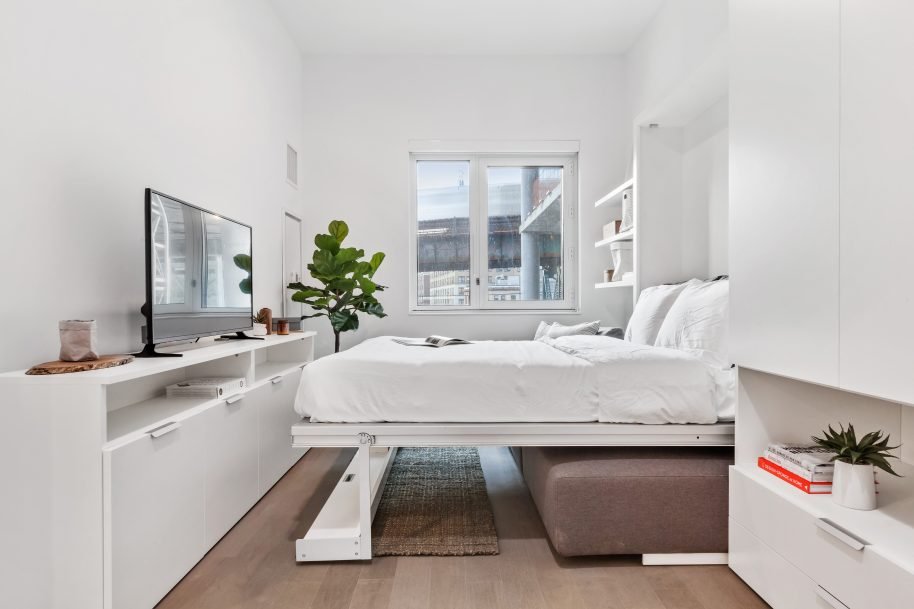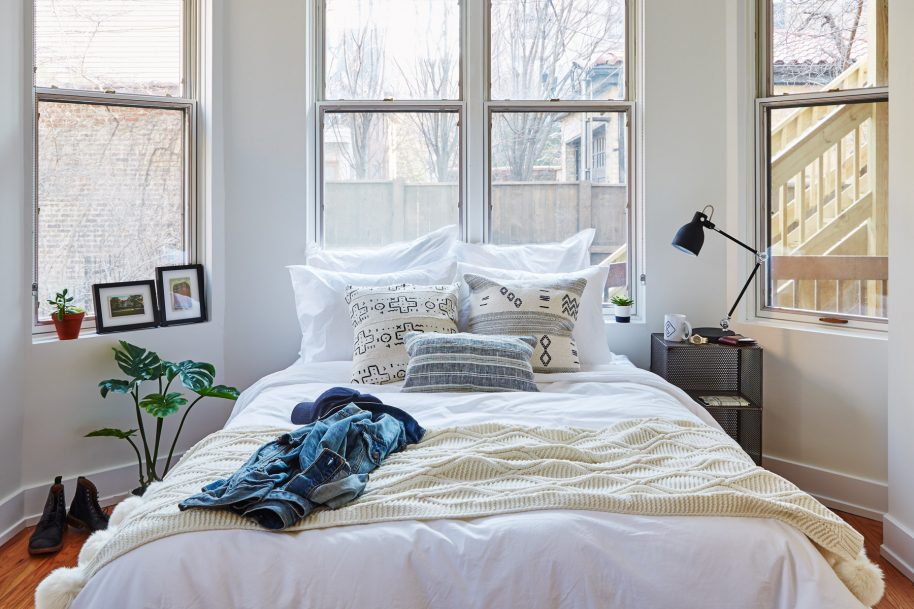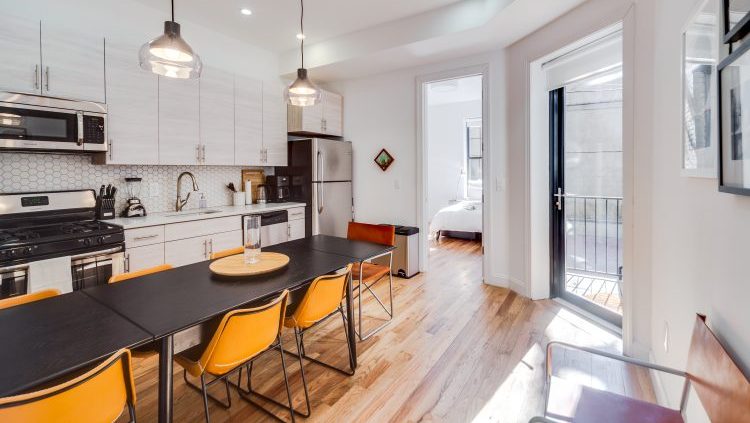Photo: Common Herkimer in New York. Provided by Common.
Co-working transformed the way we work. Now co-living is revamping the way we rent. C0-living companies combine private spaces with communal ones, simultaneously providing privacy and facilitating connection.
“Twenty-five million Americans live with roommates. That’s actually grown by 20 percent over the last 10 years,” says Brad Hargreaves, founder and CEO of Common. “There’s a lot of people sharing apartments. This is not a new thing. What is new is companies like Common are saying that there’s a better way to do it, that we can address a lot of the challenges and a lot of the issues that come with your typical Craigslist roommate share, and we can do it for a pretty similar price.”
Is the latest trend in rentals right for you? We took a look at three of the top co-living contenders in the country to find out.
WeLive

WeLive, created by the founders of WeWork, is the epitome of the sharing economy bleeding into our personal lives. Its locations in D.C. and on Wall Street are behemoths of communal space.
Offering studios to four bedrooms, WeLive’s aesthetic is DIY dorm room, with desks, beds tucked into nooks, and peg boards studded with shelves and hooks for storage. The Studio+ features two stove burners, a microwave, a mini-fridge, and a sink for those nights you want to dine alone.
But you didn’t come here for a breathtaking bachelor pad; you’re here for the human interaction. There are plenty of in-house spaces to make friends including professional kitchens, bars, hot tubs, workout studios, the lobby coffee shop, and the laundry room/arcade/game room. Sunday night communal dinners are a tradition at WeLive, and fitness classes and happy hour are offered throughout the week. An internal app keeps residents in touch, be it to plan a movie night or borrow basic household tools.
“It’s more than an apartment building,” WeWork co-founder Miguel McKelvey told CNN Money. “It’s a community of people who have come together under the premise that being together is more meaningful than being apart.”
Ollie

If you like your living space bright, modern, and minimalist, you’ll adore Ollie, a growing co-living community open now in Manhattan and Pittsburgh with locations forthcoming in Jersey City (2019), Los Angeles (2020), and Boston (2020). The Manhattan digs house 55 studio apartments sized from 260 to 360 square feet with high ceilings and Juliet balconies. Shared spaces include pools, gyms, spa areas, juice bars, lounges, and roof decks.
“For us, disrupting the housing market through co-living is very much about smart design,” says CEO and co-founder Christopher Bledsoe. “It’s not just about beautifying spaces and making people feel good in them, but it’s also about making sure that the square footage in our apartments is not excessive to a point where we’re asking a consumer to pay for space that they don’t actually need or utilize.”
Beds become sofas, dining room tables unfurl from desks, coffee tables pop up to become TV trays, and light bulbs double as Bluetooth-enabled speakers. Culturally, Ollie promotes values of inclusiveness, discovery, wellness, and sustainability. To that end, there’s Ollie Social, which gets you involved in activities like SURFSET fitness instruction, ski trips, cocktail mixology classes, or a Brooklyn chocolate tour with fellow residents. If style, function, and grown-up activities are important to you, Ollie is your next (tiny) dream abode.
Common

Don’t need the bells and whistles (and bloated prices)? Then cozy up to Common, the co-living company that offers private bedrooms in shared suites for a fraction of the cost of other co-living arrangements. Properties contain anywhere from 20 bedrooms to 150 bedrooms, and each Common member receives a private bedroom furnished with a bed, linens, pillows, nightstand, and lamp. Common’s aesthetic is traditional and home-y; its properties feature lots of natural light, exposed brick, and even stained glass windows, all outfitted with timeless furniture from brands like West Elm and Restoration Hardware. Residents share kitchens, living rooms, bathrooms, basements, laundry facilities, and outdoor spaces, all of which are cleaned weekly. Outings and activities are resident-planned.
Common boasts 19 properties total in New York, Washington D.C., San Francisco, and Chicago with future locations coming to New Orleans in 2019 and several (still unannounced) cities, making it the most ubiquitous co-living option on the market.
The Bottom Line
Co-living isn’t necessarily cheap. The more privacy you want, the higher the price tag.
Private studios at WeLive Wall Street start at $3,050 per month and run up to $7,600 per month for a four-bedroom. WeLive D.C. private studios start at $1,500 per month and four-bedrooms are priced around $3,700 per month. (Can you do enough “free” yoga/laundry/drinking/socializing to make that sticker shock seem like a bargain?)
A 278 square-foot micro studio at Ollie in Manhattan will run you $2,995 per month. In Pittsburgh, options range from $1,564 monthly for a micro studio to $3,979 monthly for a three-bedroom.
Common has the most reasonable prices, with private bedrooms clocking in at $2,450 in San Francisco, $1,650 in New York, $1,575 in Washington D.C., and $1,450 in Chicago.
Here Today, Gone Tomorrow

Co-living arrangements are ideal for those who fly by the seat of their pants and only need bedrooms that act as crash pads. You could, theoretically, show up at WeLive or Ollie or Common with just a suitcase and feel at home immediately. All units are fully furnished and most include essentials like toilet paper, paper towels, linens, and pots and pans. WeLive even has an in-house “Honesty Market” for you to purchase toiletries, pain killers, and even Ben & Jerry’s at all hours should the need arise.
Co-living leases tend to be on a month-to-month basis for maximum freedom and minimal commitment. After a six-month stay at Common, residents can transfer to a different room or home, though the company says the majority of its members are on 12-month leases and 70 percent renew at the end of those leases.
Co-living isn’t as impersonal (or as expensive) as a hotel, but the transience-friendly nature of co-living could mean a constant rotation of people, some of whom you might befriend and want to get to know better. With everyone constantly on the go, how likely is it that you’ll make deep, meaningful, enduring friendships?
Sticky Situations
Rebecca Neumann, founding partner of WeLive, explained co-living this way to CBS This Morning: “It’s a new way of living centered on community and the belief that we’re basically as good as the people we surround ourselves with.”
Fair enough, but…what if the people you end up living with are awful?
WeLive and Common do not provide roommate-matching services, so if you’re going the co-tenant route, be prepared to play roommate roulette. Ollie has a Tinder-meets-Open-Table app called Bedvetter in development to help prospective residents find available units and compatible roommates.
Ollie and Common both say they head off the most common conflict – untidiness – with weekly housecleaning. Common also has a set of ground rules (i.e. guests are not allowed to sleep on the couch) and its members rely on Slack to post those “Please don’t leave dirty dishes in the sink!” messages that every roommate loves to receive. As for WeLive? It has its own internal app, where we presume one could lodge complaints (but WeLive failed to respond to our attempts to connect – oh, the irony).
Take It From Gabe
Twenty-something Gabe Guzman moved from San Francisco to Chicago two years ago. He knew he wanted to have roommates so he could meet new people, network, and get to know the city. When an ad for Common popped up on Facebook, he was intrigued. “I saw that it was really pretty and the benefits of it were amazing, so I hit them up. A few weeks later I was in their first home in Chicago and I haven’t looked back ever since,” he says.
Guzman shares space with two roommates. Because they all have different schedules, each resident gets sufficient alone time in the property. He’s met some “amazing” people and enjoys the social aspect of the living arrangements. Only paying one bill per month relieves financial stress, too.
“Common is a game-changer when it comes to living in a big city,” he says. His only caution? If you’re the type of person bothered by a spoon in the sink, co-living probably isn’t for you.








